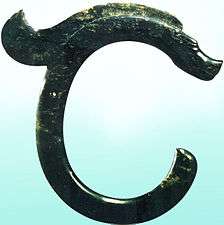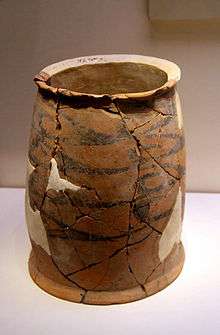Hongshan culture


The Hongshan culture (simplified Chinese: 红山文化; traditional Chinese: 紅山文化; pinyin: Hóngshān wénhuà) was a Neolithic culture in the southern part of Manchuria, in the northeastern Liao basin of China. Hongshan sites have been found in an area stretching from Inner Mongolia to Liaoning, and dated from about 4700 to 2900 BC.[1]
The culture is named after Hongshanhou (simplified Chinese: 红山後; traditional Chinese: 紅山後; pinyin: Hóngshānhòu), a site in Hongshan District, Chifeng. The Hongshanhou site was discovered by the Japanese archaeologist Torii Ryūzō in 1908 and extensively excavated in 1935 by Kōsaku Hamada and Mizuno Seiichi.[2]
Historical context
In northeast China, Hongshan culture was preceded by Xinglongwa culture (6200–5400 BC), Xinle culture (5300–4800 BC), and Zhaobaogou culture, which may be contemporary with Xinle and a little later.
Yangshao culture was in the larger area and contemporary with Hongshan culture (see map). These two cultures interacted with each other.
Artifacts

Hongshan burial artifacts include some of the earliest known examples of jade working. The Hongshan culture is known for its jade pig dragons and embryo dragons. Clay figurines, including figurines of pregnant women, are also found throughout Hongshan sites. Small copper rings were also excavated.[3]
Religion
The archaeological site at Niuheliang is a unique ritual complex associated with the Hongshan culture.
Excavators have discovered an underground temple complex—which included an altar—and also cairns in Niuheliang. The temple was constructed of stone platforms, with painted walls. Archaeologists have given it the name Goddess Temple due to the discovery of a clay female head with jade inlaid eyes.[4] It was an underground structure, 1m deep.[5] Included on its walls are mural paintings.
Housed inside the Goddess Temple are clay figurines as large as three times the size of real-life humans.[4] The exceedingly large figurines are possibly deities, but for a religion not reflective in any other Chinese culture.[6]
The existence of complex trading networks and monumental architecture (such as pyramids and the Goddess Temple) point to the existence of a "chiefdom"[7] in these prehistoric communities.
Painted pottery was also discovered within the temple.[5] Over 60 nearby tombs have been unearthed, all constructed of stone and covered by stone mounds, frequently including jade artifacts.[8]
Cairns were discovered atop two nearby two hills, with either round or square stepped tombs, made of piled limestone. Entombed inside were sculptures of dragons and tortoises.[5]
It has been suggested that religious sacrifice might have been performed within the Hongshan culture.[5]
Feng shui
Just as suggested by evidence found at early Yangshao culture sites, Hongshan culture sites also provide the earliest evidence for feng shui. The presence of both round and square shapes at Hongshan culture ceremonial centers suggests an early presence of the gaitian cosmography ("round heaven, square earth").[9]
Early feng shui relied on astronomy to find correlations between humans and the universe.[10]
Development of Chinese civilization
Some Chinese archaeologists such as Guo Da-shun see the Hongshan culture as an important stage of early Chinese civilization.[11] [12] Whatever the linguistic affinity of the ancient denizens, Hongshan culture is believed to have exerted an influence on the development of early Chinese civilization.[13] The culture may also have contributed to the development of settlements in ancient Korea. [14]
Genetics
The representatives of the Hongshan Culture location Niuheliang (6500-5000 BP) identified 3 different Y-chromosome subclades haplotypes: N1 (xN1a, N1c), C and O3a (O3a3).[15][16]
See also
References
- ↑ "Archived copy". Archived from the original on 2014-04-08. Retrieved 2014-02-01. Timeline posted by National Gallery of Art, Washington, DC.
- ↑ Hamada, Kosaku and Mizuno Seiichi. "Chifeng Hongshanhou," Archaeologia Orientalis, ser. A, No. 6. Far-Eastern Archaeology Society of Japan, (1938).
- ↑ "Iindustries include ... copper." Encyclopedia of Prehistory: Volume 3: East Asia and Oceania, Ed.: Peter N. Peregrine, Melvin Ember, Springer Science & Business Media, 2001, p. 79
- 1 2 Please refer to Niuheliang.
- 1 2 3 4 Sites of Hongshan Culture: The Niuheliang Archaeological Site, the Hongshanhou Archaeological Site, and Weijiawopu Archaeological Site unesco.org
- ↑ "Archived copy". Archived from the original on 2008-02-11. Retrieved 2017-02-05. Article by National Gallery of Art, Washington, DC.
- ↑ University of Pittsburgh, Pennsylvania: Regional Lifeways and Cultural Remains in the Northern Corridor: Chifeng International Collaborative Archaeological Research Project. Cited references: Drennan 1995; and Earle 1987, 1997.
- ↑ "Archived copy". Archived from the original on 2008-02-02. Retrieved 2007-12-14. Exhibition Brochure, National Gallery of Art, Washington, DC.
- ↑ Sarah M. Nelson, Rachel A. Matson, Rachel M. Roberts, Chris Rock and Robert E. Stencel: Archaeoastronomical Evidence for Wuism at the Hongshan Site of Niuheliang, 2006.
- ↑ Sun, X. (2000) Crossing the Boundaries between Heaven and Man: Astronomy in Ancient China. In H. Selin (ed.), Astronomy Across Cultures: The History of Non-Western Astronomy. 423-454. Kluwer Academic.
- ↑ Guo, Da-Shun 1995. Hongshan and related cultures. In: The archaeology of Northeast China: beyond the Great Wall. Nelson, Sarah M. ed. 21-64. London and New York: Routledge.
- ↑ Roger Blench(2004), Stratification in the peopling of China: how far does the linguistic evidence match genetics and archaeology? p.9
- ↑ Kwang-chih Chang and Sarah Allan, The Formation of Chinese Civilization: An Archaeological Perspective, p. 65
- ↑ Keith Pratt(2006), Everlasting Flower, p.30.
- ↑ Y Chromosome analysis of prehistoric human populations in the West Liao River Valley, Northeast China
- ↑ Geographic locations and the Y-chromosome haplogroup distribution of prehistoric populations in this study
- Allan, Sarah (ed), The Formation of Chinese Civilization: An Archaeological Perspective, ISBN 0-300-09382-9
- Chang, Kwang-chih. The Archaeology of Ancient China, ISBN 0-300-03784-8
- Nelson, Sarah Milledge (ed), The Archaeology of Northeast China: Beyond the Great Wall, ISBN 0-415-11755-0
External links
| Wikimedia Commons has media related to Hongshan Culture. |
- Hongshan culture china.org.cn
- Discussion of Hongshan culture